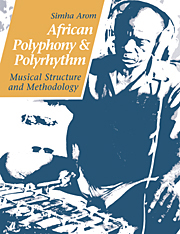Book contents
- Frontmatter
- Contents
- List of illustrations
- Foreword by György Ligeti
- Preface
- Acknowledgements
- BOOK I THE MUSIC OF THE CENTRAL AFRICAN REPUBLIC
- Map
- 1 General introduction
- 2 The general features of traditional music
- 3 Typology
- BOOK II AFRICAN POLYPHONIC MUSIC
- BOOK III TECHNICAL TOOLS: METHODS OF RECORDING POLYPHONIC MUSIC FOR TRANSCRIPTION
- BOOK IV THEORETICAL TOOLS
- BOOK V THE ORGANISATION OF TIME IN AFRICAN MUSIC
- BOOK VI STRUCTURAL PRINCIPLES AND THEIR APPLICATION
- Conclusion
- Bibliography
2 - The general features of traditional music
Published online by Cambridge University Press: 27 January 2010
- Frontmatter
- Contents
- List of illustrations
- Foreword by György Ligeti
- Preface
- Acknowledgements
- BOOK I THE MUSIC OF THE CENTRAL AFRICAN REPUBLIC
- Map
- 1 General introduction
- 2 The general features of traditional music
- 3 Typology
- BOOK II AFRICAN POLYPHONIC MUSIC
- BOOK III TECHNICAL TOOLS: METHODS OF RECORDING POLYPHONIC MUSIC FOR TRANSCRIPTION
- BOOK IV THEORETICAL TOOLS
- BOOK V THE ORGANISATION OF TIME IN AFRICAN MUSIC
- BOOK VI STRUCTURAL PRINCIPLES AND THEIR APPLICATION
- Conclusion
- Bibliography
Summary
INTRODUCTION
Before presenting a sketch of the general characteristics of the musics to be found in Central Africa, such as their social functions and their relations with language and with dance, let us remind the reader, when approaching traditional African cultures, to be wary of relying too much on the rationality inherent in Western thought, with its tendency to distinguish and to categorise.
I have shown elsewhere that in African civilisations the world is almost invariably apprehended in the multiplicity of its aspects as a dynamic ensemble, as a coherent whole displaying a diversity whose elements are not only not mutually exclusive but rather tend to complement each other. All of these elements are linked by a multiplicity of bundles of relations internal to a universe which implies no separation of the metaphysical from the physical (Arom 1974: 3–6).
Consequently, the notion of art, and that of musical art in particular, in sub-Saharan Africa depends upon quite other mental categories than it does in the West. As Senghor observes:
Negro-African civilization stems from a unitary vision of the world. None of the domains into which the ‘human sciences’ of the West artificially divide it enjoys an autonomous existence. The same spirit prompts and links Negro-African philosophy, religion, society and art. And their philosophy, which is ontology, expresses their psycho-physiology.Art itself is simply one of many artisanal techniques, the one that is most effective for identifying with one's ancestor or for integrating with the vital force of God. For the latter is the source of life itself, which in Black Africa is the supreme good.[…]
- Type
- Chapter
- Information
- African Polyphony and PolyrhythmMusical Structure and Methodology, pp. 6 - 15Publisher: Cambridge University PressPrint publication year: 1991



